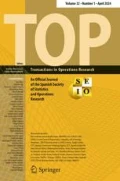Abstract
The aim of this paper is to present a method for selecting the optimal tree among the possible trees that can be generated starting from the a data set. Analysis a quantity criterion is used through the linear combination of the quality measurements of the tree, namely, resubstitution error and linearity. The application of the method leads to a succession of optimal trees, in such a way, that an element of the succession is associated with each possible value of the linear combination's parameter α.
Similar content being viewed by others
References
Arbab, B. and D. Michie (1988). Generating Expert Rules from Examples in Prolog.Machine Intelligence,11; 289–304.
Breiman, L., J. H. Friedman, R. A. Olshen and C. J. Stone (1984).Classification and Regression Trees. The Wadsworth Statistics/Probability Series. Monterey, California.
Ciampi, A., C. H. Chang, S. Hogg and S. Mckineey (1987). Recursive partition: A versatile method for exploratory data analysis in biostatistics. InProceedings from Joshi Festschrift, G. Umphrey (ed), 23–50. Amsterdam: North-Holland.
Ciampi, A. (1989). Generalized Regression Trees.Computational Statistics and Data Analysis,12, 1, 57–78.
Cuesta, P. (1989). Inducción en bancos de datos cualitativos. Tesis Doctoral. Facultad de Matemáticas. Universidad Complutense de Madrid.
Goodman L. and W. Kruskal (1954). Measures of Association for Cross Classifications.JASA,49; 732–764.
Guegun, A. and J. P. Nakache (1988). Methode de Discrimination Basée sur la construction d'un Arbre de Décision Binaire.Revue de Statistique Appliquée,36; 19–38.
Hartigan, J. (1975).Clustering Algorithms. New York: Wiley and Sons.
Munduate, A. (1993). Cuestiones notables en la construcción y comparación de árboles de decisión. Tesis Doctoral. Departamento de Métodos Estadísticos. Universidad Pública de Navarra.
Author information
Authors and Affiliations
Rights and permissions
About this article
Cite this article
Del Rio, A.M., Cano Sevilla, F.J. & Prados, A.P. Linearity criterion for the selection of an optimal tree. Top 5, 127–142 (1997). https://doi.org/10.1007/BF02568534
Received:
Accepted:
Issue Date:
DOI: https://doi.org/10.1007/BF02568534




